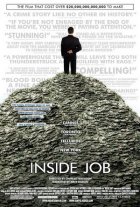
Inside Job Page #5
01:
27:34.12REP. BARNEY FRANK: Thirty years ago, if you went to get a loan for a home, the
person lending you the money expected you to pay him or her back. You got a loan
from a lender who wanted you to pay him back. We've since developed securitization,
whereby the people who make the loan are no longer at risk if there is a failure to repay.
01:
27:51.21NARRATOR:
In the old system, when a homeowner paid their mortgage every month,the money went to their local lender. And since mortgages took decades to repay,
lenders were careful.
In the new system, lenders sold the mortgages to investment banks. The investment
banks combined thousands of mortgages and other loans — including car loans, student
loans, and credit-card debt — to create complex derivatives, called collateralized debt
obligations, or CDOs. The investment banks then sold the CDOs to investors.
Now, when homeowners paid their mortgages, the money went to investors all over the
world.
01:
28:33.11 The investment banks paid rating agencies to evaluate the CDOs, andmany of them were given a AAA rating, which is the highest possible investment grade.
This made CDOs popular with retirement funds, which could only purchase highly rated
securities.
01:
28:50.05 This system was a ticking time bomb. Lenders didn't care anymore aboutwhether a borrower could repay, so they started making riskier loans. The investment
banks didn't care, either; the more CDOs they sold, the higher their profits. And the
rating agencies, which were paid by the investment banks, had no liability if their ratings
of CDOs proved wrong.
01:
29:17.11{GILLIAN TETT
U.S. MANAGING EDITOR
THE FINANCIAL TIMES}
GILLIAN TETT:
You weren't gonna be on the hook; and there weren't regulatoryconstraints. Um, so it was a green light to just pump out more and more and more
loans.
Inside Job transcript – Sony Pictures – September 2010
24
NARRATOR:
Between 2000 and 2003, the number of mortgage loans made each yearnearly quadrupled.
NOURIEL ROUBINI:
Everybody in this, uh, securitization food chain, from the verybeginning until the end; they didn't care about the quality of the mortgage; they were
caring about maximizing their volume, and getting a fee out of it.
01:
29:46.05NARRATOR:
In the early 2000s, there was a huge increase in the riskiest loans, calledsubprime. But when thousands of subprime loans were combined to create CDOs,
many of them still received AAA ratings.
01:
30:03.06CHARLES FERGUSON: Now it would have been possible to create derivative products
that don't have these risks –
GILLIAN TETT:
Um-hm.CHARLES FERGUSON: – that carry the equivalent of deductibles, where there are
limits on the risks that can be taken on, and so forth. They didn't do that, did they?
01:
30:19.08GILLIAN TETT:
They didn't do that; and in retrospect, they should have done.CHARLES FERGUSON: So did these guys know that they were doing something
dangerous?
SAM HAYES:
I think they did.{THE INVESTMENT BANKS ACTUALLY PREFERRED SUBPRIME
LOANS, BECAUSE THEY CARRIED HIGHER INTEREST RATES.
THIS LED TO A MASSIVE INCREASE IN PREDATORY LENDING.}
{BORROWERS WERE NEEDLESSLY PLACED IN EXPENSIVE
SUBPRIME LOANS, AND MANY LOANS WERE GIVEN
TO PEOPLE WHO COULD NOT REPAY THEM.}
01:
30:44.12ROBERT GNAIZDA:
All the incentives that the financial institutions offered to theirmortgage brokers were based on selling the most profitable products, which were
predatory loans.
Inside Job transcript – Sony Pictures – September 2010
25
01:
30:55.00{ERIC HALPERIN
DIRECTOR, CENTER FOR RESPONSIBLE LENDING
WASHINGTON, DC}
ERIC HALPERIN:
The banker makes more money if they put you in a subprime loan,that's where they're gonna, that's where they're gonna put ya.
01:
31:00.00{PART II:
THE BUBBLE(2001-2007)}
NARRATOR:
Suddenly, hundreds of billions of dollars a year were flowing through thesecuritization chain. Since anyone could get a mortgage, home purchases and housing
prices skyrocketed. The result was the biggest financial bubble in history.
MAN:
Real estate is real. They can see their asset; they can live in their asset; they canrent out their asset.
01:
31:27.05CHARLES MORRIS:
You had a huge boom in housing, that made no sense at all. Thefinancing appetites of the financial sector drove what everybody else did.
NOURIEL ROUBINI:
Last time we had a housing bubble was in the late '80s. In thatcase, the increase in home price had been relatively minor. That housing bubble led to
a relatively severe recession.
From 1996 until 2006, real home prices effectively doubled.
01:
32:07.12VOICE OVER:
At 500 dollars a ticket, they've come to hear how to buy their very ownpiece of the American dream.
ROBERT GNAIZDA:
Goldman Sachs; Bear Stearns; Lehman Brothers; Merrill Lynch,were all in on this. The uh, p-, sub-, subprime lending alone increased from 30 billion a
year in funding to over 600 billion a year, in 10 years. They knew what was happening.
01:
32:33.15NARRATOR:
Countrywide Financial, the largest subprime lender, issued 97 billiondollars’ worth of loans. It made over 11 billion dollars in profits as a result.
Inside Job transcript – Sony Pictures – September 2010
26
01:
32:46.22 On Wall Street, annual cash bonuses spiked. Traders and CEOs becameenormously wealthy during the bubble.
Lehman Brothers was a top underwriter of subprime lending; and their CEO, Richard
Fuld, took home 485 million dollars.
01:
33:05.04NOURIEL ROUBINI:
On Wall Street, this housing and credit bubble was leading, uh, tohundreds of billions of dollars of profits. You know, by 2006, about 40 percent of all
profits of S&P 500 firms was coming from financial institutions.
01:
33:20.09{MARTIN WOLF
CHIEF ECONOMICS COMMENTATOR
THE FINANCIAL TIMES}
MARTIN WOLF:
It wasn't real profits, it wasn't real income; it was just money that wasbeing created by the system, and booked as income two, three years down the road.
There's a default; it's all wiped out.
I think this was, in fact, in retrospect, a great big national — and not just national, global
— Ponzi scheme.
01:
33:38.27NARRATOR:
Through the Home Ownership and Equity Protection Act, the FederalReserve Board had broad authority to regulate the mortgage industry. But Fed
Chairman Alan Greenspan refused to use it.
REP. BARNEY FRANK: Alan Greenspan said, no, that's regulation; ideologically, I don't
believe in it.
NARRATOR:
For 20 years, Robert Gnaizda was the head of Greenlining, a powerfulconsumer advocacy group. He met with Greenspan on a regular basis.
01:
34:04.17ROBERT GNAIZDA:
We gave him an example of Countrywide, and 150 differentcomplex adjustable-rate mortgages. And he said: If you had a doctorate in math, you
wouldn't be able to understand them enough to know which was good for you and which
wasn't.
Translation
Translate and read this script in other languages:
Select another language:
- - Select -
- 简体中文 (Chinese - Simplified)
- 繁體中文 (Chinese - Traditional)
- Español (Spanish)
- Esperanto (Esperanto)
- 日本語 (Japanese)
- Português (Portuguese)
- Deutsch (German)
- العربية (Arabic)
- Français (French)
- Русский (Russian)
- ಕನ್ನಡ (Kannada)
- 한국어 (Korean)
- עברית (Hebrew)
- Gaeilge (Irish)
- Українська (Ukrainian)
- اردو (Urdu)
- Magyar (Hungarian)
- मानक हिन्दी (Hindi)
- Indonesia (Indonesian)
- Italiano (Italian)
- தமிழ் (Tamil)
- Türkçe (Turkish)
- తెలుగు (Telugu)
- ภาษาไทย (Thai)
- Tiếng Việt (Vietnamese)
- Čeština (Czech)
- Polski (Polish)
- Bahasa Indonesia (Indonesian)
- Românește (Romanian)
- Nederlands (Dutch)
- Ελληνικά (Greek)
- Latinum (Latin)
- Svenska (Swedish)
- Dansk (Danish)
- Suomi (Finnish)
- فارسی (Persian)
- ייִדיש (Yiddish)
- հայերեն (Armenian)
- Norsk (Norwegian)
- English (English)
Citation
Use the citation below to add this screenplay to your bibliography:
Style:MLAChicagoAPA
"Inside Job" Scripts.com. STANDS4 LLC, 2025. Web. 23 Feb. 2025. <https://www.scripts.com/script/inside_job_42>.







Discuss this script with the community:
Report Comment
We're doing our best to make sure our content is useful, accurate and safe.
If by any chance you spot an inappropriate comment while navigating through our website please use this form to let us know, and we'll take care of it shortly.
Attachment
You need to be logged in to favorite.
Log In